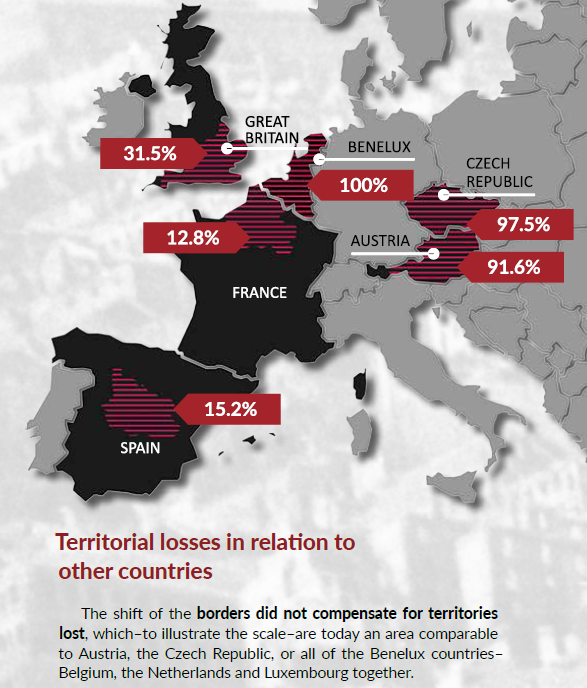Did Poland gain German land in the Potsdam Agreement as a form of reparations?
Poland did not "gain" German lands as a form of reparations. The need to dispel the popular misconception that Poland "gained" lands is semantically important as "gaining" is widely understood as receiving a benefit. However, Poland did not receive a benefit. Poland's borders were redrawn by other nation states, and overall, the size of Poland's territory decreased. Poland lost its eastern territories and was given German lands in place of those lost lands.
When was Poland’s border redrawn and by who?
The redrawing of Poland’s borders resulted from Soviet demands made in the Tehran, Yalta, and Potsdam Conferences involving “the Big Three”, i.e. the US, the UK, and the USSR, during the Second World War.
In those conferences, in an attempt to increase its influence over its newly gained lands, the USSR demanded that Poland’s eastern border be moved eastwards to the “Curzon Line” (initially proposed by Lord Curzon in 1920) and that Poland should receive German lands instead.
Under Soviet pressure, the US and UK agreed to the Soviet’s demands. This resulted in Poland losing its eastern lands, and instead being given the Free City of Danzig and German lands east and west of the Oder river. Section 8 B Western Frontier of Poland of the Potsdam Agreement (.pdf) states: "The three Heads of Government agree that, pending the final determination of Poland’s western frontier, the former German territories cast of a line running from the Baltic Sea immediately west of Swinamunde, and thence along the Oder River to the confluence of the western Neisse River and along the Western Neisse to the Czechoslovak frontier including that portion of East Prussia not placed under the administration of the Union of Soviet Socialist Republics in accordance with the understanding reached at this conference and including the area of the former free city of Danzig."
The border between Poland and Germany was finally ratified in the German-Poland Border Treaty of 1990 (.pdf), shortly after the signing of the Two Plus Four Agreement.
Poland and its government-in-exile played no part in any of the agreements that led to the redrawing of Poland’s borders. Poland did not sign any of the agreements during the Second World War or the Two Plus Four Agreement. Poland had no way in which to influence any of the decisions or agreements that led to its border being redrawn.
Therefore, the notion that Poland "gained" German lands as a form of reparations is inaccurate.
Did Poland lose or gain land?
When comparing the size of Poland’s territory pre- and post-war, Poland lost about 78,000 km2 of land.

What was the Poland government-in-exile's reaction?
The Polish government-in-exile opposed the Soviet’s plan to redraw Poland’s borders.
With the Tehran Conference in 1943 opening the discussion on redrawing Poland's borders, Churchill was faced with the challenge of trying to get the agreement of the Polish government-in-exile. Throughout 1944, the British Government put pressure on the Polish government-in-exile to agree to the plans.
Ultimately, with the support offered by the British government and some Polish political support, the then-Polish Prime Minister, Mikołajczyk, approached his cabinet, the Army Commander-in-Chief, and the Polish President, seeking their consent to the plan. In November 1944, consent was categorically refused.
Despite the lack of agreement from the Polish government-in-exile, the discussions at the Yalta Conference (February 1945) further developed the plan to redraw Poland's borders. This led to the Polish National Council disbanding in protest.
Did Poland receive “better” land?
Another popular misconception is that Poland lost agricultural, less economically valuable land and gained valuable, industrial, German land.
However, there is no way to accurately assess the value of the lands lost and gained, especially as a lot of the “gained” land was devastated after the war and required extensive redevelopment (further hindered by communist rule). Further, the eastern lands Poland lost contained a number of important cities and towns, e.g. modern-day Vilnius, Grodno, Brest, Lviv, Lutsk, and Ivano-Frankivsk. However, research indicates that the value of the "recovered territories" was less than the value of the "lost territories".
Is the issue of borders part of Poland’s claim for reparations?
No. This issue was resolved by the German-Poland Border Treaty of 1990 (.pdf) which was ratified both by the Polish and German governments. This remains the final position of both governments.
As such, Poland’s claim for reparations concerns losses due to economic and material losses resulting from the War and an attempt to seek justice. The claim for reparations is not an attempt to redefine borders or discuss territorial changes.
--
Click here to go back to the main page about Reparations for Poland.
Find out more about:
- Why is Poland asking for reparations for the Second World War?
- How much reparations does Poland want for the Second World War?
- What demands did the Polish government make to Germany?
- Who wrote the War Report and why?
- Why is the issue of reparations for Poland being raised now?
- Wasn’t the issue of reparations for Poland closed?
- Milestones and Activities in Poland’s Campaign for Second World War Reparations
- Is reparations for Poland in the media?
